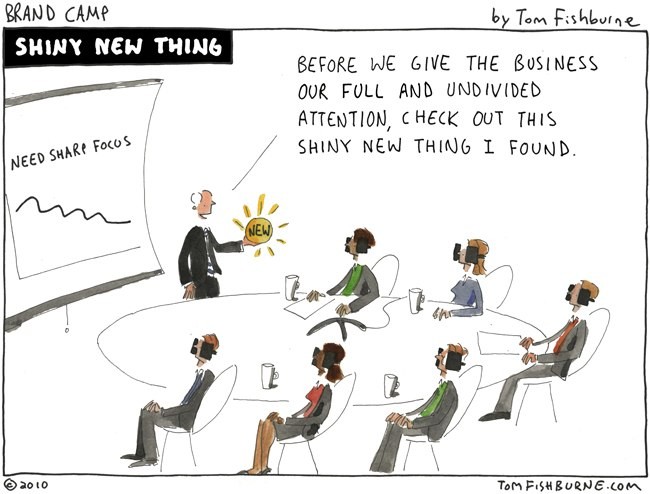Blog
Shiny Object Syndrome: The Reason Your Company is Failing at "Going Digital"
Article from Kristina Sabirova, Managing Partner of BGS Group.
Companies spent $1.3 trillion on digital transformation efforts last year, but only 1% of these efforts met or exceeded their expectations. This year, enterprises are expected to have a technology budget increase, putting investment numbers higher than last year’s. Tragically, research tells us that 70% of these initiatives will not reach their stated goals.
I have been asking myself: “Why do some digital transformation efforts succeed and others fail?”
I believe one of the main reasons today is entrepreneurs’ Shiny Object Syndrome.
During digital transformation it is possible to get distracted by the wrong things. Сompanies adopting popular technologies because they think they’re supposed to. Leaders who aim to enhance organizational performance through the use of digital technologies often have a specific tool in mind. “Our organization needs a machine learning strategy,” perhaps, when in actuality that technology has no strategic value for their company at all. While embracing this new technology may turn out to be the right choice in the long run, the initial decision may be driven by a fear of missing out rather than a well-thought-out evaluation of the benefits and relevant criteria surrounding the technology.
What Is Shiny Object Syndrome?
Shiny Object Syndrome is defined as the attraction to objects that exhibit a glassy, polished, gleaming, or otherwise shiny appearance. At its core, shiny object syndrome is a disease of distraction. As entrepreneurs, we face distractions on almost a daily basis. We get too excited. Technology is cool! It does so many amazing things! Sometimes we are like a cat chasing a laser. Spending time and money and not analysing the results.
Shiny Object Syndrome is a HUGE problem for entrepreneurs. I know this because I am one, and I do have to fight against it. We tend to be highly motivated. We crave new technology and new developments. And we aren’t afraid to start new projects and create new things. Ordinarily, these are great characteristics, but when it starts to take over, it can have some pretty serious consequences.
If you invest in all the new technologies, or you jump from platform to platform, you’ll end up
burning through so much cash that these tools become incredibly cost-inefficient.

Early in my career, my boss at that time was constantly chasing each new digital “shiny object”. He was certain that the company needed to adopt natural language processing when, in fact, this technology made little or no sense for our company. We ended up losing a lot of time, money, and effort. The smarter, more profitable choice was to begin with a thorough understanding of our goals, our strategy, and our current assets. And then to use that information to determine which digital tools were the best fit and the most cost-effective path to success.
It is critical to avoid making the wrong strategic decisions about innovations.
Leaders in many organizations lack clarity on what digital means for their strategy. They underestimate the degree at which digital is disrupting the economic underpinnings of their businesses. They also overlook the speed at which digital ecosystems are blurring industry boundaries and shifting the competitive balance. It’s very easy for a company to waste time, money, and effort chasing each new “shiny object” in digital if there isn’t a well-thought-out strategy leading the way.
Leaders who continually embrace overly-hyped innovations confuse
the hype with the real potential progress has to offer.

My close friend who is the CEO of a large real estate development company has continually looking for “the next big thing”. He always focuses too heavily on the hype surrounding an innovation, as opposed to whether the innovation can actually help solve a problem or meet a business need. This year he has been obsessed with quantum computing. When I asked him how he wants to adopt it within his company, he said he doesn’t fully understand how this technology works. But he is already planning to rework their operating models accordingly to include quantum computing. For me it's just madness to not determine how well an innovation fits within an organization’s mission, vision, culture, and structure.
It’s not only my friend’s problem, many senior executives aren’t fully fluent in what digital is. Executives who aren’t familiar with digital are investing in cool digital technologies without a clear understanding of how digital will generate value in their business models. They also are more likely to make fragmented or subscale digital investments, to pursue initiatives in the wrong order, or to skip foundational moves. Having only a remedial understanding of trends and technologies has become dangerous.
I encourage you to stop wasting your time and money. Keep in mind the adverse consequences that may arise by putting too much stock in new digital “shiny objects”. You need absolute clarity about your digital strategy before you invest in anything. You must fight guesswork through pilots and consider sampling the technology without making a full commitment.
We need to understand that digital technology is both a threat and an opportunity. The threat is the potential disruption to a business or industry. The digital opportunity is the chance to spark innovation and lay the foundation for a prosperous future. Over the past decade, this digital duality of threat and opportunity has created a new generation of corporate giants and killed off others.
ADDITIONAL OPTIONS FOR YOU:
- connect with Kristina on Linkedin for the articles on industry trends and event networking tips
- find out more about Automation and Digitalization Oil and Gas Congress AUTOMA at automacongress.com
- request marketing materials here
- share the article in social networks using the buttons below and our tag #AUTOMA2021